Services on Demand
Journal
Article
Indicators
-
 Cited by SciELO
Cited by SciELO -
 Access statistics
Access statistics
Related links
-
 Cited by Google
Cited by Google -
 Similars in
SciELO
Similars in
SciELO -
 Similars in Google
Similars in Google
Share
DYNA
Print version ISSN 0012-7353On-line version ISSN 2346-2183
Dyna rev.fac.nac.minas vol.79 no.171 Medellín Jan./Feb. 2012
UNBALANCED MAGNETRON SPUTTERING SYSTEM FOR PRODUCING CORROSION RESISTANCE MULTILAYER COATINGS
SISTEMA DE SPUTTERING CON MAGNETRÓN DESBALANCEADO PARA PRODUCIR RECUBRIMIENTOS EN MULTICAPAS RESISTENTES A LA CORROSIÓN
DIANA MARULANDA
Ph.D, Departamento de Ingeniería Mecánica y Mecatrónica, Universidad Nacional de Colombia, Sede Bogotá, dmmarulandacardo@unal.edu.co
JHON JAIRO OLAYA
Ph.D, Departamento de Ingeniería Mecánica y Mecatrónica, Universidad Nacional de Colombia, Sede Bogotá, jjolaya@unal.edu.co
Received for review January 21th, 2010, accepted February 22th, 2011, final version February, 28th, 2011
ABSTRACT: In this work, an unbalanced magnetron sputtering system which allows for the production of corrosion resistance multilayer coatings is described. The major advantage of this system is that it combines features such as a multi-cathode setup, temperature control, control over the rotation of the sample holder, and the ability to change samples without breaking the vacuum. The system was tested with the production of Cr/CrN nanometric multilayers on AISI stainless steel 304 and silicon (100) substrates and the evaluation of its corrosion resistance. X-ray diffraction (XRD) was used in order to assess the crystalline microstructure and scanning electron microscopy (SEM) was used to characterize multilayer formation. The XRD results show (111) and (200) orientations for CrN multilayer films and the SEM results clearly show the formation of a multilayer structure. Corrosion resistance was evaluated through electrochemical studies and the results show that the Cr/CrN multilayer structure presents lower corrosion current and higher corrosion potential as compared to the stainless steel 304 substrate.
KEYWORDS: unbalanced magnetron sputtering (UBM), corrosion, multilayers, Cr/CrN
RESUMEN: En este trabajo se describe un sistema de sputtering con magnetrón desbalanceado que permite producir recubrimientos en multicapa resistentes a la corrosión. La principal ventaja de este sistema es que combina características tales como una disposición multi-cátodo, control de temperatura, control sobre la rotación del portamuestras y capacidad de intercambiar muestras sin romper el vacío. El desempeño del sistema se verificó a través de la producción de multicapas nanométricas de Cr/CrN sobre acero inoxidable 304 y silicio (100) y la evaluación de su resistencia a la corrosión. Se utilizó difracción de rayos X (DRX) pare estudiar la microestructura cristalina, y microscopía electrónica de barrido (MEB) para caracterizar la formación de la multicapa. Los resultados de DRX muestran las orientaciones (111) y (200) para las multicapas de CrN y los resultados de MEB muestran claramente la formación de una estructura en multicapa. La resistencia a la corrosión se evaluó a través de estudios electroquímicos y los resultados muestran que la multicapa de Cr/CrN presenta menor corriente de corrosión y un potencial de corrosión más alto en comparación al sustrato de acero inoxidable 304.
PALABRAS CLAVE: sputtering con magnetrón desbalanceado (UBM), corrosión, multicapas, Cr/CrN
1. INTRODUCTION
The reactive unbalanced magnetron sputtering technique has been used in recent years to successfully produce several coatings such as CrNx [1] and TiN [2], and multilayers such as TiN/CrN [3]. This technique is based on the increase of the magnetic field at the external magnets of a magnetron, in such a way that some of the magnetic lines are directed towards the substrate and a certain number of electrons follow these magnetic field lines [4]. The electrons drag ions from the target toward the substrate because of coulomb attraction, and in this way, a major ionic current density is reached on the substrate. The resulting ionic bombardment has proven to be efficient in modifying film microstructure, and in obtaining major density and less roughness in the films [5,6]. The most important advantages of this technique are that it is a non-toxic process which produces minimal environmental contamination; it allows for the production of high purity, well adhered, and uniform coatings on large area substrates, in addition to high density films at low temperature. Better control on surface properties is obtained through the appropriate combination of process variables [7,8]. These variables include unbalanced grade magnetron, ion energy, ionic current density, plasma density, gas flux, discharge power (current-voltage), substrate temperature, sample-target distance, sample rotation velocity, and total pressure, among others. Controlling these process parameters allows for the modification of the properties of coatings such as microstructure, chemical composition, hardness, and mechanical, optical, electric, and magnetic characteristics. Currently, this process is an environmentally clean alternative to the decorative hard coatings and corrosion resistance coatings obtained by electrochemical processes. Development of "clean" technologies in the industrial manufacture processes is now an essential task required by laws and the programs supported by industrialized countries.
In this work, a system for producing multilayer coatings for corrosion resistance applications by using the unbalanced magnetron sputtering technique is described. The system combines instrumentation that allows one to have control over the variables previously described. Due to the current demand for high corrosion resistance coatings in aggressive environments, Cr/CrN nanometric multilayers on stainless steel and silicon have been produced by using the system described. In nanometric multilayers, the continuous re-nucleation reduces pores and therefore reduces diffusion paths toward the substrate, making the multilayer structure more corrosion resistant than monolayer coatings [9]. In this work, multilayers of approximately 1 um total thickness were produced, and their corrosion resistance was evaluated through electrochemical studies.
2. EXPERIMENTAL SETUP
2.1. Deposition system
The Cr/CrN nano-multilayers were deposited by means of the UBM technique in non-commercial equipment whose schematic diagram is shown in Fig. 1. The system is equipped with a stainless steel vacuum chamber, 1 meter in diameter and 80 centimeters long, and it is equipped with a pumping system which consists of a rotary vane mechanical pump and a turbo molecular pump with pumping velocities of 10 m3/h and 500 l/s, respectively. The base pressure is less than 10 x 10-4 Pa. A pre-chamber setup, consisting of a cross-piece 334 cm long which is joined to a manually-activated gate valve in order to stabilize pressures between the pre-chamber and the main chamber (Fig. 1(b)), lets one change samples without breaking the vacuum. A positioner is used to change samples without breaking the vacuum in the main chamber. A shutter (Fig. 1(e)) allows one to stabilize the discharge before starting the coating and also to produce multilayer coatings without shutting down the discharge.
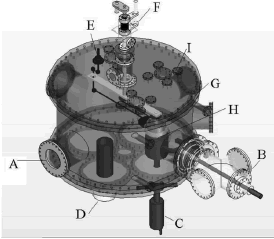
Figure 1. System overview: (a) vacuum pumps inlet, (b) pre-chamber setup, (c) GENCOA unbalanced magnetron, (d) homemade unbalanced magnetron, (e) shutter, (f) rotation and sample-target distance system, (g) heating apparatus, (h) sample holder, (i) gauge inlets for vacuum measurement
Figure 1(f) shows the part that supports the rotation system for the heater and sample holder. Rotation is performed through a DC motor which works at a non-load speed of 128 rpm and moves a set of gear wheels attached to the heater and sample holder system. The target-substrate distance can be controlled through a coil spring, and the substrate can be moved from 1 to 10 cm away from the target. The target can be moved away from the substrate through the magnetron setup in order to reach larger distances in case it is needed for bigger pieces. The heating system shown in Fig. 1(g) consists of four halogen lamps (150 W, 120 VAC), 79 mm in length, with 600 W of total power. The temperature substrate can be varied from room temperature to 400 ºC, and it is measured through a type K thermocouple and controlled through a 1000 W dimmer.
2.2. Unbalanced magnetron
A commercially variable unbalanced magnetron from the company GENCOA model PP100 permits the varying of the magnetic field through variation in the vertical distance of the central magnet (Fig. 1(c)). In this magnetron, the variation in the number of turns (NV) of a millimeter screw changes the distance between the magnet assembly and the target, leading to a variation in the magnetic field. An increment in NV corresponds to the enlarging of the distance between the central magnet and the target. The magnetic field was measured using a portable Phywe teslameter with a Hall Effect probe. Both components of the magnetic field, Bx and Bz were measured as a function of Z (axial distance), r (radial distance), and NV (number of turns). The unbalance level of the magnetron was estimated using the coefficient of geometrical unbalance KG, according to [10]:

where R is an average radius of the erosion zone (for our cathode this is 0.02 m) and Z=0 is the distance from the target surface to the point on the axis of the magnetron where the normal component of the magnetic field (Bz) has a value of zero [10].
The coefficient of geometrical unbalance (KG) was calculated according to these data in function of NV and it is shown in Fig. 2. It can be seen that KG diminishes when Nv increases. The coefficient of geometrical unbalance varies inversely to the level of unbalance of the magnetron: A high KG value implies a low level of unbalance of the magnetron and vice versa. The multilayers were produced with KG = 1.32, this represents the lowest configuration of the unbalanced magnetron used.
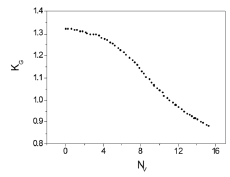
Figure 2. Level of unbalance as a function of the number of turns (NV)
2.3. Sample preparation
The system described was used to produce Cr/CrN nanometric multilayers with approximately 1 mm total thickness, a bilayer period (l) of 200 nm, 100 nm, and 20 nm, and a level of unbalance of KG = 1.32. Nanometric multilayers were produced on stainless steel AISI 304 and silicon (100) in order to evaluate corrosion resistance and microstructure characteristics. The steel samples were polished using sandpaper from 100 to 1200 and mirror polished. The silicon substrates were ultrasonically cleaned in acetone and alcohol in sequence and dried in flowing compressed air before being placed in the deposition chamber.
Chromium layers were deposited in an Ar atmosphere (99.99 purity), while for CrN layers N2 (99.99 purity) was used with flow rates of 9 and 3 sccm, respectively, that were regulated with MKS mass flow controllers. The target was a 4" diameter and 0.125" thick chromium disk (99.95% purity), and it was sputtered using a MDX power supply DC (Advanced Energy) at a power of ∼157 W for chromium deposition and ∼150 W for chromium nitride deposition. The multilayers consisted of 10, 20, and 100 layers and they were deposited by growing a chromium layer under an Ar atmosphere. Subsequently nitrogen mixed with argon was blown at intervals corresponding to planned nitride layer for chromium nitride deposition. The shutter was located between the target and the sample surface in each interval in order to stabilize deposition pressure before growth of the corresponding layer. No heating or rotation was performed and the sample-target distance was fixed at 5 cm. The measured total thickness of the multilayer was found to be approximately 1.08 um and it was measured by a stylus profilometer (Dektak). Deposition conditions are summarized in table 1.
Table 1. Deposition conditions

2.4. Multilayers characterization
Identification of the crystallographic phases and preferential orientations of the films was done by XRD using a X-pertPro Panalytical system in the
Bragg-Brentano mode with monochromatized CuKa radiation (1.540998 Å) and the cross sectional morphology of the films was studied using scanning electron microscopy (FEI-KUANTA 200) and transmission electron microscopy (TECNAI). For corrosion resistance analysis, potentiodynamic anodic polarization (PAP) studies were performed using a GILLAC-ACM electrochemical instrument, model 844 (resolution: 0.025 mV and 10 pA). The PAP tests were performed on all specimens, including the bare AISI 304 stainless steel substrate. Graphite was used as a counter electrode and the reference electrode was a saturated calomel electrode (SCE). The electrolyte was 0.5 M H2SO4 containing 0.05M KSCN.
3. RESULTS AND DISCUSSION
X-ray diffraction results can be seen in Fig. 3 and the presence of both Cr and CrN phases can be observed. The (200) plane can be seen for CrN (JCPDS 11-0065 card) which is partially overlapping the (110) Fe peak. As seen in the figure, an evolution is presented in orientation where (200) peak seems to grow preferentially for small bilayer periods, whereas a small contribution of (111) orientation appears when increasing bilayer period thickness. Similar results have been found in other works [11,12]. The peak positions related to Cr and CrN phases were found to be lower than that reported in the JCPDS card for all the cases, which indicates the presence of compressive residual stresses in the multilayers.
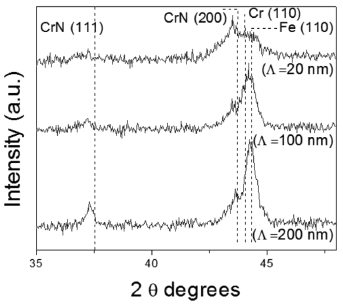
Figure 3. XRD pattern obtained from the CrN/Cr multilayers with l = 200 nm, l = 100 nm and l = 20 nm
The SEM micrographs of fracture cross-sections show a clearly defined layered structure for multilayers with l = 200 nm (Fig. 4(a)) and l = 100 nm (Fig. 4(b)). For multilayers grown with l = 20 nm, the TEM image (Fig. 5) also shows a multilayer structure.
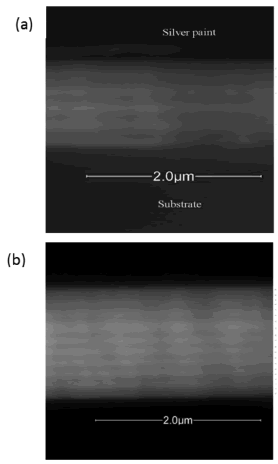
Figure 4. SEM micrographs of the cross section of (a) l = 200 nm, (b) l = 100 nm
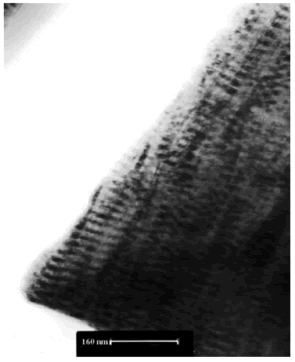
Figure 5. TEM micrograph of the cross section of (a) l = 200 nm, (b) l = 100 nm
Figure 6 shows the potentiodynamic polarization curves for the stainless steel 304 substrate and the Cr/CrN-1, Cr/CrN-2 and Cr/CrN-3 samples. Corrosion resistance of a material in the polarization curve is determined by its ability to retain low current densities as the electric potential increases. The Tafel analysis is used to quantitatively determine the corrosion potential, Ecorr, and the corrosion current density, Icorr. The values of these parameters for the different coatings and the bare substrate are presented in Table 1. Better corrosion resistance of the Cr/CrN multilayers can be seen from the more positive corrosion potential, the lower corrosion currents attaining up to two orders of magnitude lower for the coatings, and the lower passivation currents relative to the substrate.
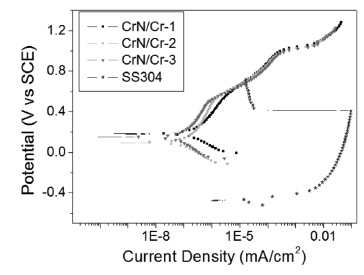
Figure 6. Potentiodynamic curves for Cr/ CrN multilayers in comparison with 304 stainless steel [18,19]
This better corrosion resistance is possibly due to the presence of interfaces that act as barriers for the diffusion of the corrosive solution towards the substrate. In general, the degradation of the coatings is increased through the generation of the mechanism of corrosion based on the diffusion of the corrosive solution toward the substrate, corrosion in the interface film-substrate and loss of adherence of the coating. However, in multilayers, the continuous re-nucleation reduces porous and diffusion paths toward the substrate making the multilayer structure more corrosion resistant than monolayer coatings [9]. This enhanced corrosion resistance in multilayers has also been found by other authors [15,16,17].
4. CONCLUSIONS
In this study, a system to produce coatings through the use of the unbalanced magnetron sputtering technique was described and Cr/CrN nanometric multilayers for use in corrosion resistance applications were successfully produced in order to assess the system performance. Through the use of this equipment and based on the results obtained, future research will be conducted on pieces of semi-industrial size which are exposed to corrosive environments
ACKNOWLEDGMENTS
This research has been financially supported by the Instituto Colombiano para el desarrollo de la Ciencia y la Tecnología "Francisco Jose de Caldas" COLCIENCIAS, through Project 1101-479-22003, CT 531-2008. The authors would like to thank Yuri Chipatecua for performing the corrosion measurements.
REFERENCES
[1] Olaya, J.J., Rodil, S.E., Muhl, S. and Huerta, L., Influence of the energy parameter on the microstructure of chromium nitride coatings, Surf. Coat. Technol., 200, pp. 5743-5750, 2006. [ Links ]
[2] Massl, S., Thomma, Keckes, W., J. and Pippan, R., Investigation of fracture properties of magnetron-sputtered TiN films by means of a FIB-based cantilever bending technique, Acta Mater., 57, pp. 1768-1776, 2009. [ Links ]
[3] Cherng-Yuh Su, Cheng-Tang Pan, Tai-Pin Liou, Po-Ta Chen and Chung-Kwei Lin. Investigation of the microstructure and characterizations of TiN/CrN nanomultilayer deposited by unbalanced magnetron sputter process, Surf. Coat. Technol., 203, pp. 657-660, 2008. [ Links ]
[4] Window, B., and Savvides, B., Unbalanced magnetron ion-assisted deposition and property modification of thin films, Vac. Sci. Technol. A., 4(3), pp. 504-508, 1986. [ Links ]
[5] Hurkmans, T., Lewis, D.B., Paritong H., Brooks, J.S. and Münz, W.D.. Influence of ion bombardment on structure and properties of unbalanced magnetron grown CrNx coatings, Surf. Coat. Technol., 114, pp. 52-50, 1999. [ Links ]
[6] Olaya Flórez, J. J, Marulanda, D., Rodil, S., Recubrimientos de nitruros metálicos depositados con UBM: tecnología eficiente y ambientalmente limpia, DYNA, 77, pp. 60-68, 2010. [ Links ]
[7] Kelly, P.J. and Arnell, R.D., Magnetron Sputtering: A Review of Recent Developments and Applications, Vacuum, 56, pp. 159-172, 2000. [ Links ]
[8] Olaya, J.J., Rodil, S.E., Muhl, S. and Sánchez, E., Comparative study of chromium nitride coatings deposited by unbalanced and balanced magnetron sputtering, Thin solid films, 474, pp. 119-126, 2005. [ Links ]
[9] Olaya, J.J., Recubrimientos de nitruros metálicos depositados con la técnica de espurreo asistido con campos magnéticos variables, [Tesis Doctoral], Instituto de Investigaciones en Materiales, UNAM, México, 2005. [ Links ]
[10] I.V. Svadkovski, D.A. Golosov and S.M. Zavatskiy. Characterisation parameters for unbalanced magnetron sputtering systems, Vacuum, 68, pp. 283-290, 2003. [ Links ]
[11] Romero, J., Esteve, J. and Lousa, A., Period dependence of hardness and microstructure on nanometric Cr/CrN multilayers Surf. Coat. Technol., 188-189, pp. 338-343, 2004. [ Links ]
[12] Kot, M., Rakowski, W.A., Major, L., Major, R. and Morgiel, J., Effect of bilayer period on properties of Cr/CrN multilayer coatings produced by laser ablation, Surf. Coat. Technol., 202, pp. 3501-3506, 2008. [ Links ]
[13] Arzt, E., Size effects in materials due to microstructural and dimensional constraints: A comparative review, Acta Mater, 46, pp. 5611-5626, 1998. [ Links ]
[14] Flores, M., Muhl, S., Huerta, L. and Andrade, E., The influence of the period size on the corrosion and the wear abrasion resistance of TiN/Ti multilayers, Surf. Coat. Technol., 200, pp. 1315-1319, 2005. [ Links ]
[15] Kaciulis, S., Mezzi, A., Montesperelli, G., Lamastra, F., Rapone, M., Casadei, F.,Valente,T. and Gusmano, G., Multi-technique study of corrosion resistant CrN/Cr/CrN and CrN : C coatings, Surf. Coat. Technol., 201, pp. 313-319, 2006. [ Links ]
[16] Bayón, R., Igartua, A., Fernández, X., Martínez, R., Rodríguez, R.J., García, J. A., Frutos, A., M.A. Arenas and J. Damborenea. Corrosion-wear behaviour of PVD Cr/CrN multilayer coatings for gear applications, Tribology International, 42, pp. 591-599, 2009. [ Links ]
[17] Marulanda, D.M., Olaya,J.J., Piratoba,U., Mariño, A. and Camps, E.. The effect of bilayer period and degree of unbalancing on magnetron sputtered Cr/CrN nano-multilayer wear and corrosion, Thin Solid Films, 519, pp. 1886- 1893, 2011. [ Links ]
[18] Chipatecua, Y. y Olaya, J.J., Resistencia a la corrosión de multicapas nanométricas de CrN/Cr depositadas con magnetrón desbalanceado, [Tesis de maestría], Universidad Nacional de Colombia, 2011. [ Links ]
[19] Chipatecua, Y., Marulanda, D. M., y Olaya J. J., Evaluación de la resistencia a la corrosión de multicapas de Cr/CrN depositadas con UBM Ingeniería e Investigación, 31, pp. 16-25, 2011. [ Links ]














